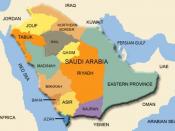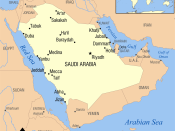Introduction
Businesses do not succeed solely due to luck, and if for some reason they do, they will not do so for a long period of time. This is because success depends on the strategic planning and execution of the company's mission, vision, goals and objectives. In a world of rapid globalization, business strategies must now consider foreign countries in their operations. This paper will provide an analysis on a possible global business venture for SBC Communications in India. Along with a country analysis, recommendations will be provided for launching a Technical Support Call Center for SBC's DSL Internet Services.
Company Background
SBC Communications is a world-class communications company that is diversified in the products and services it provides. According to its mission statement, SBC desires to be the leading provider of "voice, data, networking and e-business services, as well as directory advertising and publishing" ("News Room"). SBC and its affiliated companies provide all global, national, regional, and local services.
SBC is the leading provider of DSL broadband internet in the United States and is the nation's second largest wireline (traditional) phone company. Additionally, SBC serves more than 24 million wireless customers through Cingular wireless, of which it owns 60 percent and is the second largest wireless company. On a national level, 13 states are provided services through SBC - covering about one-third of the population. SBC also reaches 26 countries with its telecommunications investments ("News Room").
Historically, SBC has changed its services and target markets as technology has been created and evolved. The glory days of Pacific Bell were those of a simple utility company, not a communications giant. In keeping up with current off-shoring trends, SBC must continue to seek opportunities to provide the best customer service and prices to its customers.
Overview of SBC's DSL Service
Digital Subscriber Line (DSL) service is one of SBC's core service bundles that allows both businesses and consumers to access the internet. Because of the high data transfer speeds of DSL, it is considered to fall into the broadband category of internet access, along with others such as cable and satellite modems. Whenever end users are dealing with anything related to computers, there is always a potential for system compatibility problems or settings that are too detailed for many users. This is where the Technical Support Call Center for SBC's DSL Internet Services comes into play. DSL customers have come to expect world-class service from SBC and its partners. SBC feels that a 24/7 call center, staffed with friendly, patient, and knowledgeable representatives, should be available to its customers. With over 3 million SBC DSL users, the cost of funding such a call center can be quite expensive. There are typically about 150 technical support specialists on duty at any given time. These specialists do not include customer service or billing specialists, just technical support. SBC would like a way to maintain or even grow the technical support staff while also reducing soaring costs. India, with its lower wages and highly skilled labor force, may provide the solution.
SBC's Mission and Strategies
Starting at the top of the ladder for the company, the Board of Directors has decided that SBC's mission is, "to be the leading provider of voice, data, networking and e-business services, as well as directory advertising and publishing" ("News Room"). The leading provider means that SBC will excel in all areas of communications, from product selection, price, customer service, and availability and accessibility. All of these components need to be a part of the total offering for SBC to live up to its mission.
SBC's vision is to be the #1 total telecommunication provider in the United States by the year 2010 ("News Room"). It wants to provide service to the majority of Americans through all of its various products and services such as voice, data, wireless, and video. SBC is currently #2 in the nation, behind Verizon. The acquisition of AT&T Wireless that will occur in 2005 will make SBC's Cingular Wireless the largest wireless provider in the nation and give SBC a larger customer base to tap into.
In order to meet the company's high level objectives, each and every goal must align with and contribute to the Mission and Vision. A constant goal of any company is to provide more for less. A call center in India just might be the key to SBC's continued success and thriving prosperity.
Regional Political and Economic History
Direct administration by the British, which began in 1858, effected a political and economic unification of the subcontinent, the legacy of which is found in many aspects of the current Indian state, including its parliamentary system of government. When British rule came to an end in 1947, the subcontinent was partitioned along religious lines into two separate countries--India, with a majority of Hindus, and Pakistan, with a majority of Muslims. (The eastern portion of Pakistan gained independence as Bangladesh in 1971.) Although Hindi is India's official language, English continues to be widely used, especially by educated Indians in business and government ("India," 2004).
India remains one of the most ethnically diverse countries in the world. Apart from its many religions and sects, India is home to innumerable castes and tribes, as well as to more than a dozen major and hundreds of minor linguistic groups from several totally different language families. Religious minorities still account for one-sixth of the population, and Muslims alone for more than one-ninth ("India," 2004).
Economically and socially, India has made great strides since independence: it has a well-developed infrastructure and a highly diversified industrial base, its pool of scientific and engineering personnel is reputedly the third largest in the world, and the pace of its agricultural expansion has more than kept up with the growth in its population ("India," 2004). Social legislation in India has done much to alleviate the disabilities previously suffered by formerly "untouchable" castes, tribal populations, women, and other disadvantaged segments of society. At independence, India was blessed with several leaders of world stature, most notably Mohandas (Mahatma) Gandhi and Jawaharlal Nehru. Not only were these leaders able to galvanize the masses in their own country but, because of their prestige and enduring legacy, they also helped enable India to play an important role in global affairs, often as a champion of the causes of the world's colonially exploited and less developed nations ("India," 2004).
Regional Alliances
India is continuously developing as a country. It is located in southern Asia and unfortunately borders some hostile and lower economical countries. It is bounded from the north by Afghanistan, China, Nepal, and Bhutan. From the eastern side it is bounded by Bangladesh and Myanmar. India is bounded west and south by Pakistan, Palk Strait and the Gulf of Myannar. Although surrounded by impoverished and hostile countries, India has looked at those countries that are stronger in their region and has created alliances with them. They have created alliances with China, Japan, Saudi Arabia, Turkey, Burma and Nepal. With regards to foreign trade, the principal trading partner for India's exports is the United States, the United Kingdom, China, Germany and Japan. The United States is by far India's largest trading partner. India receives the bulk of its imports from the United States, the United Kingdom, Belgium, Saudi Arabia and Japan (India Foreign Trade, 2004).
Political Analysis of India
India is a constitutional republic consisting of 28 states, 6 union territories, and the Delhi national capital territory. Each state has a substantial degree of control over its own affairs, while the union territories have much lesser control. New Delhi, India's capital, is located in Delhi.
India's constitution is most heavily influenced by the British model of parliamentary democracy. A number of principles were also adopted from the U.S. Constitution that include the adoption of a federal structure, the establishment of a Supreme Court, and the separation of powers among the major branches of government. India, through its constitution, proclaims itself to be "a sovereign socialist secular democratic republic" ("India," 2004).
India has an official foreign policy of nonalignment with any of the world's major power blocs. It is a founding member and prominent leader of the Nonaligned Movement. India has also been a major player among the group of more than 100 low-income countries, loosely described as "the South," that have sought to deal collectively in economic matters with the industrialized states of "the North." India, in 1985, joined 6 nearby countries in launching the South Asian Association for Regional Cooperation ("India," 2004).
Corruption has become an increasingly important factor in Indian elections and government. The opportunity for using public resources for private benefit has been created by the extensive role of the Indian state in providing services and promoting economic development. Trading economic favors for under-the-table contributions to political parties became an increasingly widespread political practice. The 1980s and 1990s saw corruption become associated with the occupants of the highest echelons of India's political system ("Country Study," 1998).
According to the U.S. Library of Congress, "India's party system is in the throes of historic change. The 1989 general elections brought the era of Congress dominance to an end" ("Country Study," 1998). The Congress (I) regained power in 1991, but it was no longer the center of party system. Instead, it represented just one political majority strategy, and a declining one at that.
Economics in India
India has been recognized as an attractive investment destination for investment and a large and growing market for business. The fundamentals of the Indian economy have become strong and stable. There has been consistent high growth in recent years and there are definite indications of continuation of this trend in the future. India is emerging as a global player in Information Technology and is in the front position of the unfolding new era of Knowledge Economy, with its large pool of scientific and creative human resources ("Inside India," 2003). Indians have become more confident and outward looking. The Indian market is being driven by a powerful new force of entrepreneurship unleashed by the economic reforms and liberalization of recent years. Today, however, Indian outsourcing is one of the best ways for CIO's to cut application development and maintenance costs, deal effectively with the peaks and valleys of software demands, and focus on more strategic work.
Anywhere from one-half to two-thirds of all Fortune 500 companies are already outsourcing to India, and, according to Forrester Research, the amount of work done there for U.S. companies is expected to more than double this year ("Inside India," 2003). Chances are that if companies are not already sending some development or maintenance work to Mumbai or Chennai, they will soon be looking into the potential labor cost savings of 70 percent. But despite its popularity, successful outsourcing to India is still difficult. While the market has matured, telecommunications have improved and English fluency in India has flourished, challenges still remain. Cultural issues creep in, service-level expectations are set too high, transitional costs can be threatening, and ongoing relationship management is expensive and labor-intensive. Outsourcing IT services to India is still the best choice because of the maturity of software companies operating there. It has taken 10 years for India to get where they are now.
The Ministry of External Affairs for India states that India has had a 10.4 % GDP growth in the quarter ending in December 2003 and has excited hopes that India will become the next China. However, expectations need to climb even further because India now looks better than China ("Ministry of Economic Affairs," 2004)
India's Culture
India is a land of great diversity, more than any other country in the world. Four major racial groups have met and merged in India resulting in a complex demographic profile. The pale-skinned Europoid entered from the western mountain passes, coming across settled populations of Sasyu; the dark skinned ones of Rig Vedic description.
The Indian country is very old and simply complex. According to a popular estimate, it has covered a span of five thousand years since the period of its first know civilization. During this period, several strains of immigrants, representing different ethnic families and linguistic ones have merged into it and have contributed to its diversity and vitality.
India has 18 different languages that are recognized by the Indian Constitution. Hindi is the official and main language of India. Its homeland is mainly in the north of India, but it is spoken and widely understood in all urban centers of India.
There are several different levels of social evolution co-exist in India; like the hunters, the cultivators, the nomads, the itinerant traders, professionals and different artisans. India has been the cradle for the birth of the world's many great religions. Despite the diversities in the religious beliefs and practices of people, there has been a common sharing of basic fundamentals of life. Hinduism, Islam, Christianity and Buddhism are found in India each with its own rituals and beliefs.
Talk of Indian customs, traditions and culture is like going back to the beginning of history. People from far and wide were attracted to India for its ethos that speaks volumes for its eclecticism.
Conclusion
This outline begins to show why SBC should look into off-shoring to India. The organization and product have been described and an analysis has been performed on the political, economic, and cultural aspects of India. Future assignments will complete the global venture business plan.


